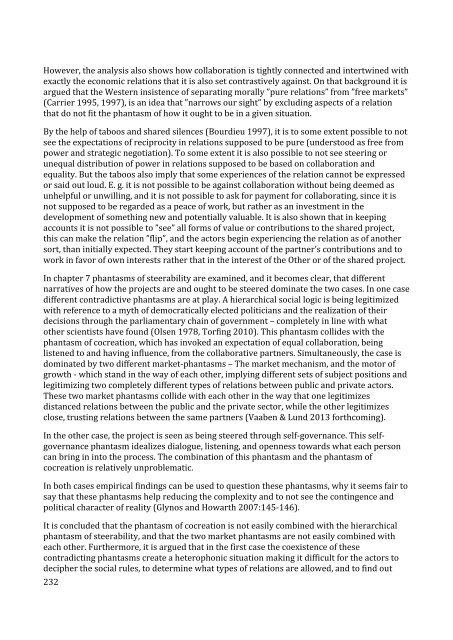phd.Nana
phd.Nana
phd.Nana
Create successful ePaper yourself
Turn your PDF publications into a flip-book with our unique Google optimized e-Paper software.
However, the analysis also shows how collaboration is tightly connected and intertwined with <br />
exactly the economic relations that it is also set contrastively against. On that background it is <br />
argued that the Western insistence of separating morally ”pure relations” from ”free markets” <br />
(Carrier 1995, 1997), is an idea that ”narrows our sight” by excluding aspects of a relation <br />
that do not fit the phantasm of how it ought to be in a given situation. <br />
By the help of taboos and shared silences (Bourdieu 1997), it is to some extent possible to not <br />
see the expectations of reciprocity in relations supposed to be pure (understood as free from <br />
power and strategic negotiation). To some extent it is also possible to not see steering or <br />
unequal distribution of power in relations supposed to be based on collaboration and <br />
equality. But the taboos also imply that some experiences of the relation cannot be expressed <br />
or said out loud. E. g. it is not possible to be against collaboration without being deemed as <br />
unhelpful or unwilling, and it is not possible to ask for payment for collaborating, since it is <br />
not supposed to be regarded as a peace of work, but rather as an investment in the <br />
development of something new and potentially valuable. It is also shown that in keeping <br />
accounts it is not possible to ”see” all forms of value or contributions to the shared project, <br />
this can make the relation ”flip”, and the actors begin experiencing the relation as of another <br />
sort, than initially expected. They start keeping account of the partner’s contributions and to <br />
work in favor of own interests rather that in the interest of the Other or of the shared project. <br />
In chapter 7 phantasms of steerability are examined, and it becomes clear, that different <br />
narratives of how the projects are and ought to be steered dominate the two cases. In one case <br />
different contradictive phantasms are at play. A hierarchical social logic is being legitimized <br />
with reference to a myth of democratically elected politicians and the realization of their <br />
decisions through the parliamentary chain of government – completely in line with what <br />
other scientists have found (Olsen 1978, Torfing 2010). This phantasm collides with the <br />
phantasm of cocreation, which has invoked an expectation of equal collaboration, being <br />
listened to and having influence, from the collaborative partners. Simultaneously, the case is <br />
dominated by two different market-‐phantasms – The market mechanism, and the motor of <br />
growth -‐ which stand in the way of each other, implying different sets of subject positions and <br />
legitimizing two completely different types of relations between public and private actors. <br />
These two market phantasms collide with each other in the way that one legitimizes <br />
distanced relations between the public and the private sector, while the other legitimizes <br />
close, trusting relations between the same partners (Vaaben & Lund 2013 forthcoming). <br />
In the other case, the project is seen as being steered through self-‐governance. This self-governance<br />
phantasm idealizes dialogue, listening, and openness towards what each person <br />
can bring in into the process. The combination of this phantasm and the phantasm of <br />
cocreation is relatively unproblematic. <br />
In both cases empirical findings can be used to question these phantasms, why it seems fair to <br />
say that these phantasms help reducing the complexity and to not see the contingence and <br />
political character of reality (Glynos and Howarth 2007:145-‐146). <br />
It is concluded that the phantasm of cocreation is not easily combined with the hierarchical <br />
phantasm of steerability, and that the two market phantasms are not easily combined with <br />
each other. Furthermore, it is argued that in the first case the coexistence of these <br />
contradicting phantasms create a heterophonic situation making it difficult for the actors to <br />
decipher the social rules, to determine what types of relations are allowed, and to find out <br />
232


